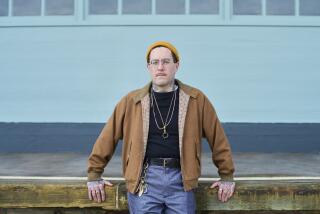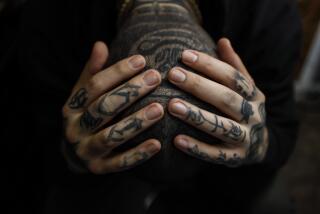Today’s Trendy Tattoos Have Character--Japanese and Chinese, That Is
CHAPEL HILL, N.C. — Morgan Garcia-Lamarca’s bare back elicits gasps and wide eyes from those who glimpse the 14-inch-long Japanese proverb inscribed down his spine.
The four black, broad-brushed characters called kanji, each four or five inches wide and filling the middle of his back, look like calligraphy that just tumbled off some ancient scroll under museum glass.
They translate to “ogre with an iron club,” a proverb Garcia-Lamarca says he embraced as his own while studying Japanese one summer. To him, it means a strong person who doesn’t have to display his strength.
But not everyone who gets a tattoo with Japanese characters can say “sayonara” or even knows what it means.
“Most of the general public thinks you can translate Japanese with a corresponding A-B-C, so that’s a problem I come up against on a fairly regular basis,” says Tom Blackmar, a custom tattoo artist in Carrboro, a Chapel Hill suburb.
That lack of knowledge hasn’t dimmed the wish by an increasing number of Americans, especially those in their late teens to mid-20s, to have Japanese and Chinese characters inked into their skin.
“As long as it’s not a stupid word, they don’t care about what the word is, just as long as it looks cool,” says Raleigh tattoo artist Anthony Wayne.
Wayne, who does about 250 images on skin a month, and other tattooists estimate that as much as 40% of their business consists of Japanese and Chinese characters. Some 15,000 tattoo shops are registered in the United States.
Unlike Garcia-Lamarca’s proverb, most kanji found on tattoo shop walls--and on most people’s skin--are printed in a bland, everyday variety of type.
“I didn’t want to have Courier font on my body, so I waited until someone could write beautiful calligraphy,” Garcia-Lamarca says.
The written Japanese and Chinese languages are composed not of individual letters but of ideographs or pictographs, which represent an idea or thing. Some characters consist of more than 30 strokes.
The two languages share some of the same pictographs, for instance those meaning beauty, love, woman, strength and happiness. Such concepts are the most commonly requested kanji, Wayne says.
Things borrowed from other cultures can come to have a deeper, more personal meaning, says Frances A. Moyer, director of the North Carolina Japan Center, a state-chartered information exchange on the North Carolina State University campus.
“The visual force of the Chinese and Japanese characters is startling and dramatic and has its own beauty,” Moyer says. “It’s also a personal testament of a more interesting and broader view of the world.”
Marcus Camby, who plays center for the New York Knicks basketball team, says he got two kanji tattooed on his upper right arm as “just a spur of the moment kind of thing.”
Camby says the two characters, “strive” or “encourage” and “family,” together mean “strive to be the best” and “love your family” in Chinese, although experts say the two kanji would never appear together in either language.
“I think I started a trend,” Camby says in remarks supplied by the Knicks. “You are starting to see lots of Chinese tattoos around now.”
Rachel Elliott, 20, says she went to a tattoo parlor in Durham looking for either a Japanese or Celtic tattoo. She couldn’t find any Celtic selections, so she chose a flash art, or ready-made, kanji that was said to represent “beautiful.”
“I love it because I think it looks good,” says Elliott, a Raleigh phlebotomist studying to be a paramedic. “I think it means beautiful. That’s what they told me.”
In business since 1949, tattoo artist Lyle Tuttle counts Janis Joplin, Peter Fonda, Joan Baez and “all the members of the Allman Brothers” among his customers. He owned the San Francisco Tattoo Museum until the 1989 earthquake destroyed his building.
In a phone interview from San Francisco, Tuttle spoke loquaciously about traditional Japanese tattoos, which he says are elaborate, multicolored pictures that tell a story and can cover a person’s body. But he turns away requests--even e-mails from as far away as Croatia, he says--to write specific things in kanji.
Tuttle instead suggests customers talk to native speakers.
“I tell them, ‘Go to your local Chinese restaurants.’ ”
Some people do just that, says Dave Tollefson, a Chapel Hill furniture designer who has the character for “infinity” tattooed on his left arm.
He asked one restaurant worker to write the character meaning infinity for him, along with two other kanji as a sort of control. When Chinese speakers at other restaurants produced the same kanji for infinity, he knew he had the right one.
A cashier at the Golden Dragon restaurant in Raleigh says people walk in all the time, asking for help with kanji they admire or looking for a kanji with a specific meaning.
“They’re eager to know what it means. They ask me how to spell certain symbols,” Suan Quo says. The kanji for “faith” or “forever” are popular requests, she says.
The kanji trend doesn’t impress those who speak or read Japanese or Chinese.
Jin Yang, a 24-year-old N.C. State student from China, says kanji tattoos may look cool to other Americans but don’t always make sense to native speakers.
“I see a lot of tattoos with ‘girl power’--the kanji for woman and the kanji for power,” Yang says. “But in China, there’s no reference to the Spice Girls, so it wouldn’t make sense.”
Michihiro Kono, a Raleigh restaurateur from the Japanese island of Kyushu, says Americans with kanji inscribed on their skin amuse him.
“I laugh because it’s very typical --they don’t know what it means,” Kono says. “A true Japanese tattoo has meaning. Kanji is not a Japanese tattoo; it’s just a tattoo.”
More to Read
Sign up for Essential California
The most important California stories and recommendations in your inbox every morning.
You may occasionally receive promotional content from the Los Angeles Times.










